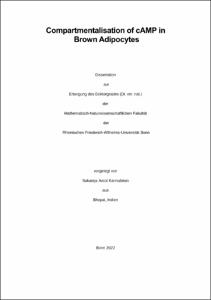Arcot Kannabiran, Sukanya: Compartmentalisation of cAMP in Brown Adipocytes. - Bonn, 2022. - Dissertation, Rheinische Friedrich-Wilhelms-Universität Bonn.
Online-Ausgabe in bonndoc: https://nbn-resolving.org/urn:nbn:de:hbz:5-65522
Online-Ausgabe in bonndoc: https://nbn-resolving.org/urn:nbn:de:hbz:5-65522
@phdthesis{handle:20.500.11811/9614,
urn: https://nbn-resolving.org/urn:nbn:de:hbz:5-65522,
author = {{Sukanya Arcot Kannabiran}},
title = {Compartmentalisation of cAMP in Brown Adipocytes},
school = {Rheinische Friedrich-Wilhelms-Universität Bonn},
year = 2022,
month = feb,
note = {The second messenger, 3',5'-cyclic adenosine monophosphate (cAMP) plays an important role in governing the function and differentiation of brown adipocytes. Upon the stimulation of Gs-coupled G protein-coupled receptors (GPCRs) adenylate cyclases are activated, which in turn produce cAMP. In cells, the levels of cyclic nucleotide regulated and controlled by phosphodiesterases (PDEs). This tight regulation of PDEs over cAMP enables them to generate subcellular microdomains. Given the importance of cAMP in brown adipocyte signalling, not much is known about how the spatio-temporal architecture of cAMP in adipocytes is organised. This study focussed on monitoring the cAMP dynamics real-time in pre- and mature murine brown adipocytes upon the activation of Gs-coupled GPCRs, namely the most widely studied different β-adrenergic receptors (β-ARs) and with some preliminary insights on adenosine (A2A and A2B) receptors. The expression of different PDEs and their various subtypes were confirmed via immunoblotting and qPCR analysis. Of interest for this study were PDE2, PDE3 and PDE4. Subcellular fractionation of these PDEs in brown adipocytes revealed their localisation mainly in the cytosol. Therefore, live cell imaging was established in murine pre- and mature brown adipocytes isolated from transgenic mice expressing a cytosolic Förster Resonance Energy Transfer (FRET) based biosensor (Epac1-camps).
Firstly, cAMP compartmentation was studied in individual β-AR subtypes. Under the activation of every β-AR subtype, PDE4 was the main regulator of cytosolic cAMP in brown preadipocytes. While in mature adipocytes, upon β1-AR activation, PDE3 and PDE4 tightly controlled cAMP pools. This could be due to the upregulation of PDE3 on protein levels upon differentiation. Surprisingly, increase in PDE3 protein expression had no influence on controlling β3-induced cAMP, and the control of PDE4 was diminished in mature brown adipocytes. This led to a possible hypothesis that different loco-regio pools of cAMP could exist in brown adipocytes, one involving association of β1-AR with PDE3/4 in the cytosol, while another could be one with β3-AR more controlled by PDEs from other membrane compartments. These results could be recapitulated functionally, wherein lipolysis assay revealed that PDE3/4 tightly control β1-AR activated, whereas this control was lost in β3-AR initiated cAMP facilitating brown adipocyte lipolysis.
Upon the stimulation of Gs-coupled adenosine receptors (A2A and A2B), PDE2 and PDE4 tightly control cAMP compartmentation in preadipocytes and the reason for this could also be that these PDEs are lowly expressed on protein levels. The regulation of PDE3 and PDE4 on A2A and A2B receptor-initiated cAMP was similar to the pattern observed with β3-AR activation indicating that these PDEs regulate receptors involved in process of activating brown adipocyte thermogenesis similarly.},
url = {https://hdl.handle.net/20.500.11811/9614}
}
urn: https://nbn-resolving.org/urn:nbn:de:hbz:5-65522,
author = {{Sukanya Arcot Kannabiran}},
title = {Compartmentalisation of cAMP in Brown Adipocytes},
school = {Rheinische Friedrich-Wilhelms-Universität Bonn},
year = 2022,
month = feb,
note = {The second messenger, 3',5'-cyclic adenosine monophosphate (cAMP) plays an important role in governing the function and differentiation of brown adipocytes. Upon the stimulation of Gs-coupled G protein-coupled receptors (GPCRs) adenylate cyclases are activated, which in turn produce cAMP. In cells, the levels of cyclic nucleotide regulated and controlled by phosphodiesterases (PDEs). This tight regulation of PDEs over cAMP enables them to generate subcellular microdomains. Given the importance of cAMP in brown adipocyte signalling, not much is known about how the spatio-temporal architecture of cAMP in adipocytes is organised. This study focussed on monitoring the cAMP dynamics real-time in pre- and mature murine brown adipocytes upon the activation of Gs-coupled GPCRs, namely the most widely studied different β-adrenergic receptors (β-ARs) and with some preliminary insights on adenosine (A2A and A2B) receptors. The expression of different PDEs and their various subtypes were confirmed via immunoblotting and qPCR analysis. Of interest for this study were PDE2, PDE3 and PDE4. Subcellular fractionation of these PDEs in brown adipocytes revealed their localisation mainly in the cytosol. Therefore, live cell imaging was established in murine pre- and mature brown adipocytes isolated from transgenic mice expressing a cytosolic Förster Resonance Energy Transfer (FRET) based biosensor (Epac1-camps).
Firstly, cAMP compartmentation was studied in individual β-AR subtypes. Under the activation of every β-AR subtype, PDE4 was the main regulator of cytosolic cAMP in brown preadipocytes. While in mature adipocytes, upon β1-AR activation, PDE3 and PDE4 tightly controlled cAMP pools. This could be due to the upregulation of PDE3 on protein levels upon differentiation. Surprisingly, increase in PDE3 protein expression had no influence on controlling β3-induced cAMP, and the control of PDE4 was diminished in mature brown adipocytes. This led to a possible hypothesis that different loco-regio pools of cAMP could exist in brown adipocytes, one involving association of β1-AR with PDE3/4 in the cytosol, while another could be one with β3-AR more controlled by PDEs from other membrane compartments. These results could be recapitulated functionally, wherein lipolysis assay revealed that PDE3/4 tightly control β1-AR activated, whereas this control was lost in β3-AR initiated cAMP facilitating brown adipocyte lipolysis.
Upon the stimulation of Gs-coupled adenosine receptors (A2A and A2B), PDE2 and PDE4 tightly control cAMP compartmentation in preadipocytes and the reason for this could also be that these PDEs are lowly expressed on protein levels. The regulation of PDE3 and PDE4 on A2A and A2B receptor-initiated cAMP was similar to the pattern observed with β3-AR activation indicating that these PDEs regulate receptors involved in process of activating brown adipocyte thermogenesis similarly.},
url = {https://hdl.handle.net/20.500.11811/9614}
}






